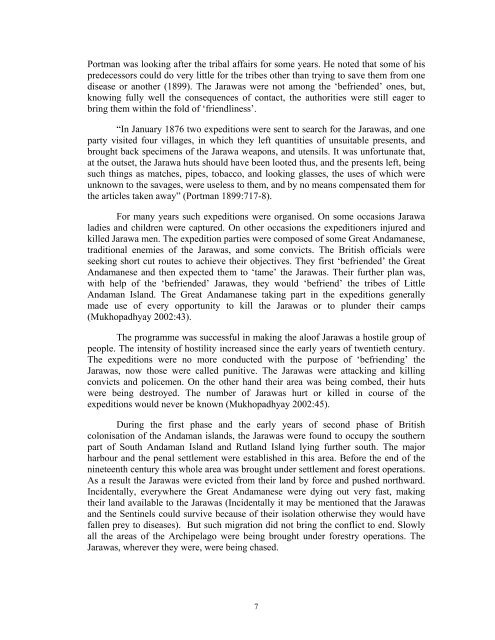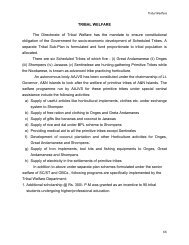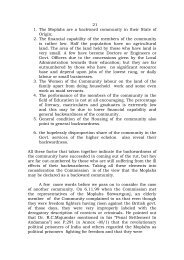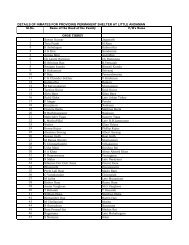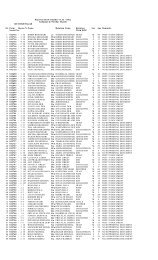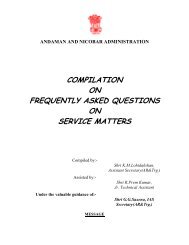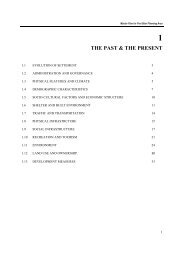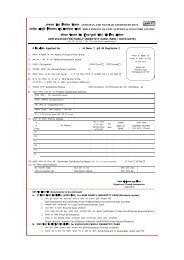1 Introduction - Andaman and Nicobar Islands
1 Introduction - Andaman and Nicobar Islands
1 Introduction - Andaman and Nicobar Islands
Create successful ePaper yourself
Turn your PDF publications into a flip-book with our unique Google optimized e-Paper software.
Portman was looking after the tribal affairs for some years. He noted that some of his<br />
predecessors could do very little for the tribes other than trying to save them from one<br />
disease or another (1899). The Jarawas were not among the ‘befriended’ ones, but,<br />
knowing fully well the consequences of contact, the authorities were still eager to<br />
bring them within the fold of ‘friendliness’.<br />
“In January 1876 two expeditions were sent to search for the Jarawas, <strong>and</strong> one<br />
party visited four villages, in which they left quantities of unsuitable presents, <strong>and</strong><br />
brought back specimens of the Jarawa weapons, <strong>and</strong> utensils. It was unfortunate that,<br />
at the outset, the Jarawa huts should have been looted thus, <strong>and</strong> the presents left, being<br />
such things as matches, pipes, tobacco, <strong>and</strong> looking glasses, the uses of which were<br />
unknown to the savages, were useless to them, <strong>and</strong> by no means compensated them for<br />
the articles taken away” (Portman 1899:717-8).<br />
For many years such expeditions were organised. On some occasions Jarawa<br />
ladies <strong>and</strong> children were captured. On other occasions the expeditioners injured <strong>and</strong><br />
killed Jarawa men. The expedition parties were composed of some Great <strong>Andaman</strong>ese,<br />
traditional enemies of the Jarawas, <strong>and</strong> some convicts. The British officials were<br />
seeking short cut routes to achieve their objectives. They first ‘befriended’ the Great<br />
<strong>Andaman</strong>ese <strong>and</strong> then expected them to ‘tame’ the Jarawas. Their further plan was,<br />
with help of the ‘befriended’ Jarawas, they would ‘befriend’ the tribes of Little<br />
<strong>Andaman</strong> Isl<strong>and</strong>. The Great <strong>Andaman</strong>ese taking part in the expeditions generally<br />
made use of every opportunity to kill the Jarawas or to plunder their camps<br />
(Mukhopadhyay 2002:43).<br />
The programme was successful in making the aloof Jarawas a hostile group of<br />
people. The intensity of hostility increased since the early years of twentieth century.<br />
The expeditions were no more conducted with the purpose of ‘befriending’ the<br />
Jarawas, now those were called punitive. The Jarawas were attacking <strong>and</strong> killing<br />
convicts <strong>and</strong> policemen. On the other h<strong>and</strong> their area was being combed, their huts<br />
were being destroyed. The number of Jarawas hurt or killed in course of the<br />
expeditions would never be known (Mukhopadhyay 2002:45).<br />
During the first phase <strong>and</strong> the early years of second phase of British<br />
colonisation of the <strong>Andaman</strong> isl<strong>and</strong>s, the Jarawas were found to occupy the southern<br />
part of South <strong>Andaman</strong> Isl<strong>and</strong> <strong>and</strong> Rutl<strong>and</strong> Isl<strong>and</strong> lying further south. The major<br />
harbour <strong>and</strong> the penal settlement were established in this area. Before the end of the<br />
nineteenth century this whole area was brought under settlement <strong>and</strong> forest operations.<br />
As a result the Jarawas were evicted from their l<strong>and</strong> by force <strong>and</strong> pushed northward.<br />
Incidentally, everywhere the Great <strong>Andaman</strong>ese were dying out very fast, making<br />
their l<strong>and</strong> available to the Jarawas (Incidentally it may be mentioned that the Jarawas<br />
<strong>and</strong> the Sentinels could survive because of their isolation otherwise they would have<br />
fallen prey to diseases). But such migration did not bring the conflict to end. Slowly<br />
all the areas of the Archipelago were being brought under forestry operations. The<br />
Jarawas, wherever they were, were being chased.<br />
7


